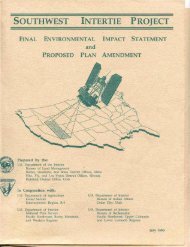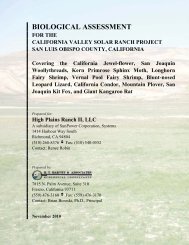Bureau of Land Management's Decision Record and Environmental
Bureau of Land Management's Decision Record and Environmental
Bureau of Land Management's Decision Record and Environmental
You also want an ePaper? Increase the reach of your titles
YUMPU automatically turns print PDFs into web optimized ePapers that Google loves.
Jersey Valley Geothermal Development Project<br />
<strong>Environmental</strong> Assessment: NV063-EAO8-091<br />
did not observe any sage-grouse sign within the transmission line corridor during their 2008<br />
survey.<br />
Pygmy Rabbit<br />
Pygmy rabbits are North America’s smallest rabbits, <strong>and</strong> the only rabbits that commonly<br />
construct their own burrows, usually in st<strong>and</strong>s <strong>of</strong> tall, dense sagebrush in locations with deep,<br />
loose soils. Pygmy rabbits are patchily distributed throughout most <strong>of</strong> the Great Basin. Though<br />
locally common, these animals have apparently never been generally abundant during historical<br />
times, <strong>and</strong> may have undergone serious population declines, habitat <strong>and</strong> population<br />
fragmentation, <strong>and</strong> local extinction in recent decades. Pygmy rabbits are sagebrush obligates <strong>and</strong><br />
their decline is probably closely related to loss <strong>and</strong> degradation <strong>of</strong> sagebrush habitats<br />
(Stamm 2006).<br />
Pygmy habitat was marginal within the surveyed portions <strong>of</strong> the Jersey Valley Unit Area <strong>and</strong><br />
neither pygmy rabbits nor their sign (i.e. burrows, droppings, etc.) were observed (GBE 2008).<br />
The sagebrush associated with some <strong>of</strong> the drainages crossed by the transmission line corridor<br />
appeared to be suitable habitat for the pygmy rabbit. These drainages were extensively surveyed<br />
<strong>and</strong> no pygmy rabbits or their sign were observed during the field survey (GBE 2008).<br />
Lahontan beardtongue<br />
Lahontan beardtongue is a tall perennial herb with w<strong>and</strong>-like stems <strong>and</strong> showy pink tubular<br />
flowers with darker markings. It is typically found along washes, roadsides <strong>and</strong> canyon floors,<br />
particularly on carbonate-containing substrates, usually where subsurface moisture is available<br />
throughout most <strong>of</strong> the summer (NNHP 2001c). It is found at elevations between 3,400 <strong>and</strong><br />
4,550 feet amsl.<br />
Given the elevation <strong>and</strong> soils within the Jersey Valley Unit Area, suitable habitat could exist.<br />
However, the only water sources available throughout the summer were the hot springs <strong>and</strong> the<br />
associated soils are not suitable for this species. No Lahontan beardtongue was observed during<br />
the survey period within the Jersey Valley Unit Area (GBE 2008). Within the transmission line<br />
corridor, neither Lahontan beardtongue populations nor suitable habitat were observed<br />
(GBE 2008).<br />
Windloving buckwheat<br />
At high elevations the Windloving buckwheat is found on dry, exposed, relatively barren <strong>and</strong><br />
undisturbed, gravelly, limestone or volcanic ridges <strong>and</strong> ridgeline knolls, on outcrops or shallow<br />
rocky soils over bedrock, with Artemisia arbuscula, Ericameria viscidflora, Poa secunda,<br />
Elymus elymoides, Arenaria kingii, etc. At low elevations the Windloving buckwheat is found on<br />
dry, relatively barren <strong>and</strong> undisturbed knolls <strong>and</strong> slopes <strong>of</strong> light-colored, platy volcanic tuff<br />
weathered to form stiff clay soils, on all aspects, with Tetradymia canescens, Ericameria<br />
nauseosa, E. viscidiflora, Atrilex confertifolia, Elymus elymoides, Elymus cinereus, Astragalus<br />
calycosus, etc (NNHP 2001a).<br />
- 46 -







